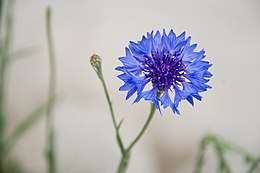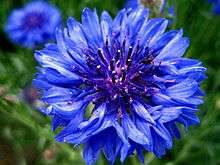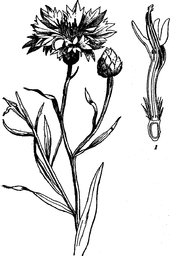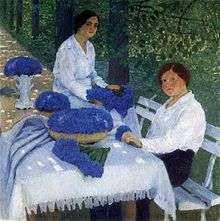Centaurea cyanus
Centaurea cyanus, commonly known as cornflower or bachelor's button,[note 1] is an annual flowering plant in the family Asteraceae, native to Europe. In the past it often grew as a weed in cornfields (in the broad sense of "corn", referring to grains, such as wheat, barley, rye, or oats), hence its name. It is now endangered in its native habitat by agricultural intensification, particularly over-use of herbicides, destroying its habitat. It is also, however, through introduction as an ornamental plant in gardens and a seed contaminant in crop seeds, now naturalised in many other parts of the world, including North America and parts of Australia.
| Centaurea cyanus | |
|---|---|
 | |
| Centaurea cyanus (introduced species) near Peshastin, Chelan County, Washington | |
| Scientific classification | |
| Kingdom: | Plantae |
| Clade: | Tracheophytes |
| Clade: | Angiosperms |
| Clade: | Eudicots |
| Clade: | Asterids |
| Order: | Asterales |
| Family: | Asteraceae |
| Genus: | Centaurea |
| Species: | C. cyanus |
| Binomial name | |
| Centaurea cyanus | |
Description
Cornflower is an annual plant growing to 40–90 cm tall, with grey-green branched stems. The leaves are lanceolate, 1–4 cm long. The flowers are most commonly an intense blue colour, produced in flowerheads (capitula) 1.5–3 cm diameter, with a ring of a few large, spreading ray florets surrounding a central cluster of disc florets. The blue pigment is protocyanin, which in roses is red.[3] It flowers all summer.[4]
Distribution
.jpg)
Centaurea cyanus is native to temperate Europe, but is widely naturalized outside its native range. It has been present in the British Isles as an archaeophyte (ancient introduction) since the Iron Age.[5] In the United Kingdom it has declined from 264 sites to just 3 sites in the last 50 years.[6] In reaction to this, the conservation charity Plantlife named it as one of 101 species it would actively work to bring 'back from the brink'.[7] In Co. Clare (VC H9), Ireland, Centaurea cyanus is recorded in arable fields as very rare and almost extinct,[8] while in the north-east of Ireland it was abundant before the 1930s.[9]
Cultivation


It is grown as an ornamental plant in gardens, where several cultivars have been selected with varying pastel colours, including pink and purple. Cornflower is also grown for the cutflower industry in Canada for use by florists. The most common colour variety for this use is a doubled blue variety such as 'Blue Boy' or 'Blue Diadem'. White, pink, lavender and black (actually a very dark maroon) are also used but less commonly. Cornflowers germinate quickly after planting.
Light requirements: full sun. Water requirements: high-average water daily. Soil pH requirements: neutral (6.6-7.5) to mildly alkaline (7.6-7.8).
Uses
The edible flower of the cornflower can be used for culinary decoration, for example to add colour to salads. Cornflowers have been used historically for their blue pigment. Cornflowers are often used as an ingredient in some tea blends and herbal teas.[10]
Cornflower seed is one of the favourite foods of the European goldfinch.
Folklore and symbolism



I. Disk-floret in vertical section
In folklore, cornflowers were worn by young men in love; if the flower faded too quickly, it was taken as a sign that the man's love was not returned.[11]:126
The blue cornflower has been the national flower of Estonia since 1918 and symbolizes daily bread to Estonians. It is also the symbol of the Estonian Conservative People's Party, the Finnish National Coalition Party, and the Liberal People's Party of Sweden, where it has since the dawn of the 20th century been a symbol for social liberalism. It is the official flower of the Swedish province of Östergötland and the school flower of Winchester College and also of Dulwich College, where it is said to have been the favourite flower of the founder, Edward Alleyn.
The blue cornflower was one of the national symbols of Germany.[12] This is partly due to the story that when Queen Louise of Prussia was fleeing Berlin and pursued by Napoleon's forces, she hid her children in a field of cornflowers and kept them quiet by weaving wreaths for them from the flowers. The flower thus became identified with Prussia, not least because it was the same color as the Prussian military uniform.[13] After the unification of Germany in 1871, it went on to become a symbol of the country as a whole. For this reason, in Austria the blue cornflower is a political symbol for pan-German and rightist ideas.[14][15] It was worn as a secret symbol identifying members of the then-illegal NSDAP in Austria in the 1930s.[16][17] Members of the Freedom Party wore it at the openings of the Austrian parliament since 2006.[18][19][20] After the last general election 2017 they replaced it with the edelweiss.[21]
It was also the favourite flower of Louise's son Kaiser Wilhelm I.[22] Because of its ties to royalty, authors such as Theodor Fontane have used it symbolically, often sarcastically, to comment on the social and political climate of the time.
The cornflower is also often seen as an inspiration for the German Romantic symbol of the Blue Flower.
Due to its traditional association with Germany, the cornflower has been made the official symbol of the annual German-American Steuben Parade.
In France the bleuet de France is the symbol of the 11 November 1918 armistice and, as such, a common symbol for veterans (especially the now defunct poilus of World War I), similar to the Remembrance poppies worn in the United Kingdom and in Canada.[23]
The cornflower is also the symbol for motor neurone disease and amyotrophic lateral sclerosis.[24]
Cornflowers are sometimes worn by Old Harrovians, former pupils of the British Harrow School.
A blue cornflower was used by Corning Glass Works for the initial release of Corning Ware Pyroceram cookware. Its popularity in the United States, Canada, United Kingdom and Australia was so high that it became the symbol of Corning Glass Works.
In paintings
 Isaac Levitan, Cornflowers, 1894.
Isaac Levitan, Cornflowers, 1894. Sergei Osipov (artist)Sergei Osipov, Cornflowers (painting) Cornflowers, 1976.
Sergei Osipov (artist)Sergei Osipov, Cornflowers (painting) Cornflowers, 1976. Igor Grabar, Group Portrait with Cornflowers, 1914.
Igor Grabar, Group Portrait with Cornflowers, 1914. Vincent van Gogh, Wheat Field with Cornflowers, 1890.
Vincent van Gogh, Wheat Field with Cornflowers, 1890.
See also
Notes
References
- Rosamond Richardson, 2017, Britain's Wildflowers. Pavilion.
- Grigson, Geoffrey (1975). The Englishman's Flora. Frogmore: Paladin. p. 419. ISBN 0586082093.
- Shiono M, Matsugaki N, Takeda K (2005). "Structure of the blue cornflower pigment". Nature. 436 (7052): 791. doi:10.1038/436791a. PMID 16094358.
- Rose, Francis (1981). The Wild Flower Key. Frederick Warne & Co. pp. 386–387. ISBN 0-7232-2419-6.
- "Online atlas of the British & Irish flora: Centaurea cyanus (Cornflower)". Biological Records Centre and Botanical Society of Britain and Ireland. Retrieved 22 May 2016.
- "Action plan for Centaurea cyanus". Ukbap.org.uk. Archived from the original on 21 February 2009. Retrieved 5 November 2009.
- Gopher Systems Ltd, Pewsey, Wiltshire, UK - Web Design & Development in Southern England. "Plantlife website". Plantlife.org.uk. Archived from the original on 27 January 2010. Retrieved 5 November 2009.CS1 maint: uses authors parameter (link)
- Skeffington, M.S. (2015). "Cornflower (Centaurea cynanus L.) and Good-king-henry (Chenopodium bonus-henricus L.)". Irish Naturalists' Journal. 34: 27–31.
- Hackney, P. (1992). Stewart & Corry's Flora of the North-east of Ireland (Third ed.). Institute of Irish Studies and The Queen's University of Belfast. ISBN 0-85389-446-9.
- Archived December 10, 2008, at the Wayback Machine
- Howard, Michael (1987). Traditional Folk Remedies. Century.
- Cleene, Marcel; Lejeune, Marie Claire (2002). Compendium of Symbolic and Ritual Plants in Europe: Herbs. Man & Culture.
The Cornflower was once the floral emblem of Germany (hence the German common name Kaiserblume).
- Reid, Marilyn (2007). Mythical Flower Stories. Lulu.com. p. 40. ISBN 978-1-84753-521-4.
- Whiteside, Andrew G. (1993). Pan-Germanism: Anti-Semitism in Mass-Style Politics. Current Research on Anti-Semitism: Hostages of Modernization. 3/2. de Gruyter. p. 691.
- Unowsky, Daniel L. (2005). The Pomp and Politics of Patriotism: Imperial Celebrations in Habsburg Austria, 1848–1916. Purdue University Press. p. 157.
- "RIS Dokument". www.ris.bka.gv.at (in German). Retrieved 24 March 2018.
- New far-right German party adopts former secret Nazi symbol The Guardian, 2019
- "Anklänge an illegale NSDAPler". ORF.at. 30 October 2006.
- "KPÖ:". www.kpoe.at (in German). Retrieved 24 March 2018.
- "Wirbel um Nazi-Blume bei der FPÖ". 29 October 2013. Retrieved 24 March 2018.
- "FPÖ-Mandatare tragen heute Edelweiß statt Kornblume". Retrieved 24 March 2018.
- Coulter, Lynn (2009). Gardening with Heirloom Seeds: Tried-and-True Flowers, Fruits, and Vegetables for a New Generation. ReadHowYouWant.com, Limited. p. 165. ISBN 978-1-4587-2217-1.
- "Le Bleuet de France - Page d'accueil". Bleuetdefrance.fr. Retrieved 5 November 2009.
- "The Cornflower - an ALS symbol". Als.ca. 31 May 2004. Archived from the original on 26 July 2009. Retrieved 5 November 2009.
External links
| Wikimedia Commons has media related to Centaurea cyanus. |
| Wikispecies has information related to Centaurea cyanus |
| Look up centaurea cyanus in Wiktionary, the free dictionary. |